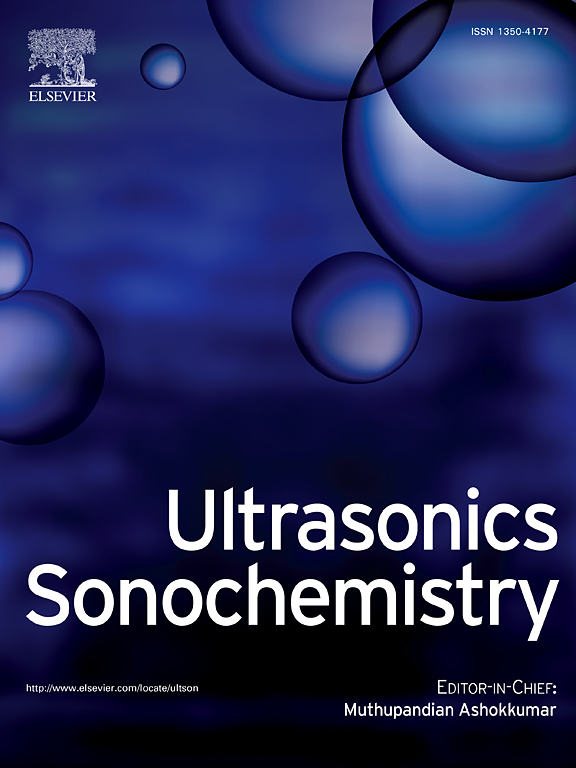Synthesis of nanoparticles of feroxyhyte doped with lanthanum by a sonochemical method
IF 8.7
1区 化学
Q1 ACOUSTICS
引用次数: 0
Abstract
This work deals with the sonochemical synthesis of colloidal dispersions of magnetic nanoparticles formed by lanthanum-doped iron oxyhydroxides coated with citrate. Our aim is to obtain bimodal contrast agents with magnetic properties that allow their use in both resonance and X-ray techniques.
For this purpose, three synthesis strategies have been developed using a combination of ultrasound and co-precipitation methods. Three ultrasound frequencies were used in the synthesis: 581, 861 or 1141 kHz. The structural characterization of the prepared materials was carried out by X-ray diffraction (XRD), transmission electron microscopy (TEM), Raman spectroscopy, total reflection X-ray fluorescence (TXRF) and Scanning Electron Microscopy/Energy Dispersive X-ray Spectroscopy (SEM/EDX)
In the presence of lanthanum, magnetite cannot be formed. Instead, an orange-brown magnetic compound is obtained. Both XRD diffraction patterns and Raman spectra confirmed that the obtained compound is a feroxyhyte containing an amorphous lanthanum compound in its structure. The size of the feroxyhyte nano-discs remained almost constant when the ultrasound frequency was increased. The La/Fe molar ratio of the samples obtained increases when La(OH)3, which is prepared in the preliminary stages, is added rather than LaCl3. This procedure makes it possible to control the amount of lanthanum absorbed by the sample by simply varying its initial concentration.

声化学法制备掺杂镧的氧化铁纳米颗粒
这项工作涉及到用柠檬酸盐包覆镧掺杂氧化铁形成的磁性纳米颗粒胶体分散体的声化学合成。我们的目标是获得具有磁性的双峰造影剂,允许它们在共振和x射线技术中使用。为此,已经开发了三种合成策略,使用超声和共沉淀方法的组合。合成中使用了三种超声波频率:581、861或1141 kHz。采用x射线衍射(XRD)、透射电镜(TEM)、拉曼光谱(Raman spectroscopy)、全反射x射线荧光(TXRF)和扫描电镜/能量色散x射线能谱(SEM/EDX)对制备的材料进行了结构表征。相反,得到了一种橙棕色的磁性化合物。XRD衍射图和拉曼光谱均证实该化合物为含非晶态镧化合物的铁氧化物。随着超声频率的增加,铁氧氢纳米片的尺寸基本保持不变。当初始阶段制备的La(OH)3而不是LaCl3加入时,得到的样品的La/Fe摩尔比增加。这种方法可以通过简单地改变样品的初始浓度来控制样品吸收镧的量。
本文章由计算机程序翻译,如有差异,请以英文原文为准。
求助全文
约1分钟内获得全文
求助全文
来源期刊

Ultrasonics Sonochemistry
化学-化学综合
CiteScore
15.80
自引率
11.90%
发文量
361
审稿时长
59 days
期刊介绍:
Ultrasonics Sonochemistry stands as a premier international journal dedicated to the publication of high-quality research articles primarily focusing on chemical reactions and reactors induced by ultrasonic waves, known as sonochemistry. Beyond chemical reactions, the journal also welcomes contributions related to cavitation-induced events and processing, including sonoluminescence, and the transformation of materials on chemical, physical, and biological levels.
Since its inception in 1994, Ultrasonics Sonochemistry has consistently maintained a top ranking in the "Acoustics" category, reflecting its esteemed reputation in the field. The journal publishes exceptional papers covering various areas of ultrasonics and sonochemistry. Its contributions are highly regarded by both academia and industry stakeholders, demonstrating its relevance and impact in advancing research and innovation.
 求助内容:
求助内容: 应助结果提醒方式:
应助结果提醒方式:


